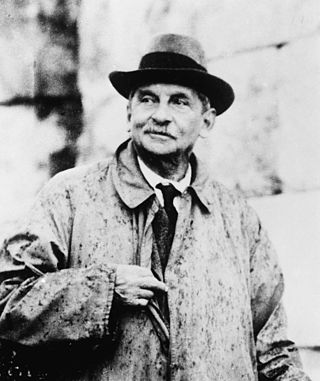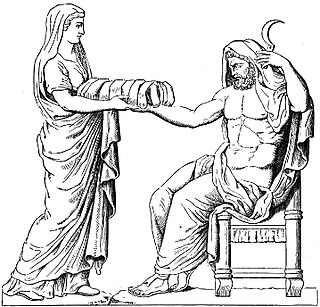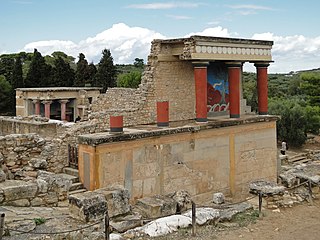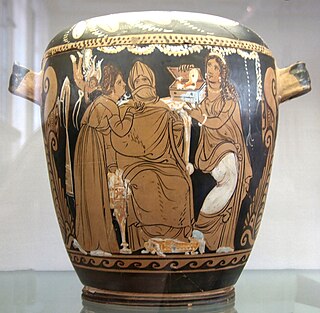Related Research Articles

In Greek mythology, the Minotaur is a mythical creature portrayed during classical antiquity with the head and tail of a bull and the body of a man or, as described by Roman poet Ovid, a being "part man and part bull". He dwelt at the center of the Labyrinth, which was an elaborate maze-like construction designed by the architect Daedalus and his son Icarus, upon command of King Minos of Crete. The Minotaur was eventually killed by the Athenian hero Theseus.

Theseus was a divine hero and the founder of Athens from Greek mythology. The myths surrounding Theseus, his journeys, exploits, and friends, have provided material for storytelling throughout the ages.

Sir Arthur John Evans was a British archaeologist and pioneer in the study of Aegean civilization in the Bronze Age.

Rhea or Rheia is a mother goddess in ancient Greek religion and mythology, the Titan daughter of the earth goddess Gaia and the sky god Uranus, himself a son of Gaia. She is the older sister of Cronus, who was also her consort, and the mother of the five eldest Olympian gods and Hades, king of the underworld.

According to Greek mythology, the Korybantes or Corybantes were the armed and crested dancers who worshipped the Phrygian goddess Cybele with drumming and dancing. They are also called the Kurbantes in Phrygia.

The Minoan civilization was a Bronze Age culture which was centered on the island of Crete. Known for its monumental architecture and energetic art, it is often regarded as the first civilization in Europe. The ruins of the Minoan palaces at Knossos and Phaistos are popular tourist attractions.

Knossos is a Bronze Age archaeological site in Crete. The site was a major center of the Minoan civilization and is known for its association with the Greek myth of Theseus and the minotaur. It is located on the outskirts of Heraklion, and remains a popular tourist destination.

The Battle of Crete, codenamed Operation Mercury, was a major Axis airborne and amphibious operation during World War II to capture the island of Crete. It began on the morning of 20 May 1941, with multiple German airborne landings on Crete. Greek and other Allied forces, along with Cretan civilians, defended the island. After only one day of fighting, the Germans had suffered heavy casualties and the Allied troops were confident that they would defeat the invasion. The next day, through communication failures, Allied tactical hesitation, and German offensive operations, Maleme Airfield in western Crete fell, enabling the Germans to land reinforcements and overwhelm the defensive positions on the north of the island. Allied forces withdrew to the south coast. More than half were evacuated by the British Royal Navy and the remainder surrendered or joined the Cretan resistance. The defence of Crete evolved into a costly naval engagement; by the end of the campaign the Royal Navy's eastern Mediterranean strength had been reduced to only two battleships and three cruisers.

Diogenes, also known as Diogenes the Cynic or Diogenes of Sinope, was a Greek philosopher and one of the founders of Cynicism. He was born in Sinope, an Ionian colony on the Black Sea coast of Anatolia, in 412 or 404 BC and died at Corinth in 323 BC.

The gymnasium in Ancient Greece functioned as a training facility for competitors in public games. It was also a place for socializing and engaging in intellectual pursuits. The name comes from the Ancient Greek term gymnós, meaning "naked" or "nude". Only adult male citizens were allowed to use the gymnasia.
Lycurgus was the legendary lawgiver of Sparta. He is credited with establishing the military-oriented reformation of Spartan society in accordance with the Oracle of Apollo at Delphi. All his reforms promoted the three Spartan virtues: equality, military fitness, and austerity.

Ioannis Vlachos, better known as Daskalogiannis was a wealthy shipbuilder and shipowner who led a Cretan revolt against Ottoman rule in the 18th century.

Pederasty in ancient Greece was a socially acknowledged romantic relationship between an older male and a younger male usually in his teens. It was characteristic of the Archaic and Classical periods. The influence of pederasty on Greek culture of these periods was so prevalent that it has been called "the principal cultural model for free relationships between citizens."
The syssitia were, in ancient Greece, common meals for men and youths in social or religious groups, especially in Crete and Sparta, but also in Megara in the time of Theognis of Megara and Corinth in the time of Periander.
The Delia were festivals and games celebrated in classical antiquity at the great celebratory gathering (panegyris) on the island of Delos.
Syrtos is – in classical and modern Greece – a traditional dance in which the dancers link hands to form a chain or circle, headed by a leader who intermittently breaks away to perform improvised steps.

In Ancient Greek religion and mythology, Cronus, Cronos, or Kronos was the leader and youngest of the first generation of Titans, the divine descendants of the primordial Gaia and Uranus. He overthrew his father and ruled during the mythological Golden Age, until he was overthrown by his own son Zeus and imprisoned in Tartarus. According to Plato, however, the deities Phorcys, Cronus, and Rhea were the eldest children of Oceanus and Tethys.

In Greek mythology, Leucippus was a young man of Phaistos, Crete. Leucippus was born to Lamprus, the son of Pandion, and Galatea, daughter of Eurytius the son of Sparton. He is notable for having undergone a magical gender transformation by the will of the goddess Leto. Due to his transition from female to male, Leucippus can be considered a transgender male figure in Greek mythology.

Titus 1 is the first chapter of the Epistle to Titus in the New Testament of the Christian Bible. The letter is traditionally attributed to Paul the Apostle, sent from Nicopolis of Macedonia, addressed to Titus in Crete. Some scholars argue that it is the work of an anonymous follower, written after Paul's death in the first century AD. This chapter contains the greetings and instructions for Titus on dealing with deceivers.

Marriage in ancient Greece had less of a basis in personal relationships and more in social responsibility, however it is important to note; the available historical records on the subject focus exclusively on Athens or Sparta and primarily on the aristocratic class. According to these records, the goal and focus of all marriages was intended to be reproduction, making marriage an issue of public interest. Marriages were usually arranged by the parents; on occasion professional matchmakers were used. Each city was politically independent and each had its own laws concerning marriage. For the marriage to be legal, the woman's father or guardian gave permission to a suitable man who could afford to marry. Daughters were usually married to uncles or cousins. Wintertime marriages were popular due to the significance of that time to Hera, the goddess of marriage. The couple participated in a ceremony which included rituals such as veil removal, but it was the couple living together that made the marriage legal. Marriage was understood to be the official transition from childhood into adulthood for women.
References
- Ephorus, ap. Strab. x. p. 480, &c.; Heracl. Pont. c. 3.; Hock, Creta^ iii. p. 100, &c.; Muller, Dor. iv. 5. § 3; Hermann, Griech. Staatsaltertliumer, § 22; Wachsmuth, Hellen. Alterthumskunde, vol. i. p. 362, 2d ed.; Krause, Die Gymnastik u. Agonistik d. Hellenen, p. 690, &c.)
![]() This article incorporates text from a publication now in the public domain : Smith, William, ed. (1870). "Agela". Dictionary of Greek and Roman Antiquities . London: John Murray.
This article incorporates text from a publication now in the public domain : Smith, William, ed. (1870). "Agela". Dictionary of Greek and Roman Antiquities . London: John Murray.